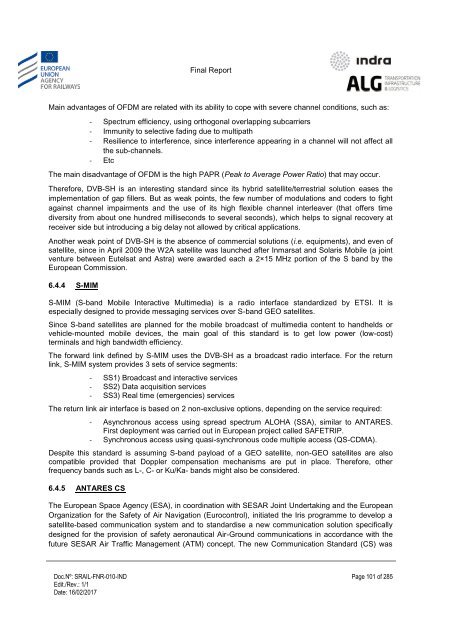Study on feasibility of SATCOM for railway communication
SRAIL-FNR-010-IND%20-%20FinalReport_v1.1_20170216
SRAIL-FNR-010-IND%20-%20FinalReport_v1.1_20170216
Create successful ePaper yourself
Turn your PDF publications into a flip-book with our unique Google optimized e-Paper software.
Final Report<br />
Main advantages <strong>of</strong> OFDM are related with its ability to cope with severe channel c<strong>on</strong>diti<strong>on</strong>s, such as:<br />
- Spectrum efficiency, using orthog<strong>on</strong>al overlapping subcarriers<br />
- Immunity to selective fading due to multipath<br />
- Resilience to interference, since interference appearing in a channel will not affect all<br />
the sub-channels.<br />
- Etc<br />
The main disadvantage <strong>of</strong> OFDM is the high PAPR (Peak to Average Power Ratio) that may occur.<br />
There<strong>for</strong>e, DVB-SH is an interesting standard since its hybrid satellite/terrestrial soluti<strong>on</strong> eases the<br />
implementati<strong>on</strong> <strong>of</strong> gap fillers. But as weak points, the few number <strong>of</strong> modulati<strong>on</strong>s and coders to fight<br />
against channel impairments and the use <strong>of</strong> its high flexible channel interleaver (that <strong>of</strong>fers time<br />
diversity from about <strong>on</strong>e hundred millisec<strong>on</strong>ds to several sec<strong>on</strong>ds), which helps to signal recovery at<br />
receiver side but introducing a big delay not allowed by critical applicati<strong>on</strong>s.<br />
Another weak point <strong>of</strong> DVB-SH is the absence <strong>of</strong> commercial soluti<strong>on</strong>s (i.e. equipments), and even <strong>of</strong><br />
satellite, since in April 2009 the W2A satellite was launched after Inmarsat and Solaris Mobile (a joint<br />
venture between Eutelsat and Astra) were awarded each a 2×15 MHz porti<strong>on</strong> <strong>of</strong> the S band by the<br />
European Commissi<strong>on</strong>.<br />
6.4.4 S-MIM<br />
S-MIM (S-band Mobile Interactive Multimedia) is a radio interface standardized by ETSI. It is<br />
especially designed to provide messaging services over S-band GEO satellites.<br />
Since S-band satellites are planned <strong>for</strong> the mobile broadcast <strong>of</strong> multimedia c<strong>on</strong>tent to handhelds or<br />
vehicle-mounted mobile devices, the main goal <strong>of</strong> this standard is to get low power (low-cost)<br />
terminals and high bandwidth efficiency.<br />
The <strong>for</strong>ward link defined by S-MIM uses the DVB-SH as a broadcast radio interface. For the return<br />
link, S-MIM system provides 3 sets <strong>of</strong> service segments:<br />
- SS1) Broadcast and interactive services<br />
- SS2) Data acquisiti<strong>on</strong> services<br />
- SS3) Real time (emergencies) services<br />
The return link air interface is based <strong>on</strong> 2 n<strong>on</strong>-exclusive opti<strong>on</strong>s, depending <strong>on</strong> the service required:<br />
- Asynchr<strong>on</strong>ous access using spread spectrum ALOHA (SSA), similar to ANTARES.<br />
First deployment was carried out in European project called SAFETRIP.<br />
- Synchr<strong>on</strong>ous access using quasi-synchr<strong>on</strong>ous code multiple access (QS-CDMA).<br />
Despite this standard is assuming S-band payload <strong>of</strong> a GEO satellite, n<strong>on</strong>-GEO satellites are also<br />
compatible provided that Doppler compensati<strong>on</strong> mechanisms are put in place. There<strong>for</strong>e, other<br />
frequency bands such as L-, C- or Ku/Ka- bands might also be c<strong>on</strong>sidered.<br />
6.4.5 ANTARES CS<br />
The European Space Agency (ESA), in coordinati<strong>on</strong> with SESAR Joint Undertaking and the European<br />
Organizati<strong>on</strong> <strong>for</strong> the Safety <strong>of</strong> Air Navigati<strong>on</strong> (Euroc<strong>on</strong>trol), initiated the Iris programme to develop a<br />
satellite-based communicati<strong>on</strong> system and to standardise a new communicati<strong>on</strong> soluti<strong>on</strong> specifically<br />
designed <strong>for</strong> the provisi<strong>on</strong> <strong>of</strong> safety aer<strong>on</strong>autical Air-Ground communicati<strong>on</strong>s in accordance with the<br />
future SESAR Air Traffic Management (ATM) c<strong>on</strong>cept. The new Communicati<strong>on</strong> Standard (CS) was<br />
Doc.Nº: SRAIL-FNR-010-IND<br />
Edit./Rev.: 1/1<br />
Date: 16/02/2017<br />
Page 101 <strong>of</strong> 285


